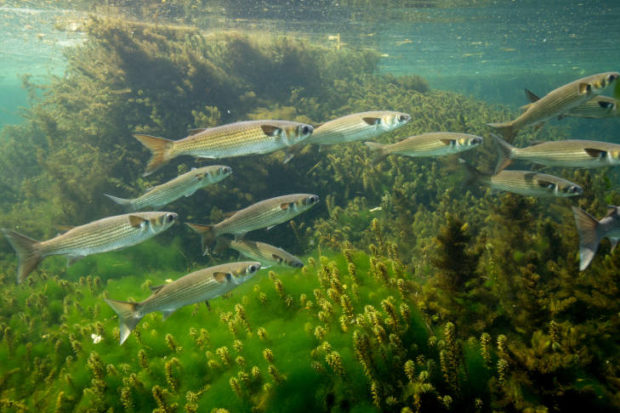We have much more to do and your continued support is needed now more than ever.
Collapse of Forage Fish Threatens Saltwater Sport Fishing

There’s a good reason why saltwater anglers obsess over the pattern, color, size, and presentation of their flies. The species anglers target rely upon the smaller forage fish that share the waters, and only by imitating these forage fish and crustacean food sources can they consistently catch redfish, tarpon, bonefish, and a host of other saltwater sport fish.
Unfortunately, most forage fish in our coastal waters have no protection to ensure they keep feeding the sport fish we rely upon as anglers, the sport-fishing industry which relies upon us, and the conservation efforts which rely on fishing licenses and excise taxes on fishing equipment. These fund state wildlife agency conservation efforts through the Federal Aid in Sport Fish Restoration Act, also known as the Dingell-Johnson Act.
The whole system is dependent on thriving forage fish populations. Forage fish like mullet, shad, herring, and sardines eat plankton, then sport fish like salmon, redfish, and tarpon eat them. Without protection, though, forage fish populations are even more susceptible to rapid drops in population. Meanwhile, factors such as rising ocean temperatures certainly aren’t helping.

Many forage fish are harvested for fish oil, fertilizer, aquaculture and livestock feed, cosmetics, pet food, and other consumer products – and demand for these products is only increasing. If we’re serious about keeping marine sport fish populations robust, we need to do a better job of considering the health of the full food web, starting at the bottom.
Most forage fish species are unprotected under our nation’s ocean fishery management law, the Magnuson-Stevens Act. And even in the cases where they are managed, forage fish are often treated as isolated fisheries without consideration of their outsized importance as prey for sport fish. Bipartisan legislation introduced in Congress would apply some common sense steps to conserve forage fish and their critical role in the marine food web, though.
My congresswoman, Rep. Debbie Dingell (D-Mich.), with Rep. Brian Mast (R-Fla.) recently introduced the Forage Fish Conservation Act (H.R. 2236), which would make a number of changes to how forage fish are managed, including:
- Providing a national, science-based definition for forage fish in federal waters;
- Assessing the impact a new commercial forage fish fishery could have on existing fisheries, fishing communities, and the marine ecosystem prior to the fishery being authorized;
- Accounting for predator needs in existing management plans for forage fish;
- Specifying that managers consider forage fish when establishing research priorities;
- Ensuring scientific advice sought by fishery managers includes recommendations for forage fish;
- Conserving and managing river herring and shad in the ocean; and
- Preserving state management of forage fish fisheries that occur within their jurisdiction.
The Forage Fish Conservation Act enjoys the support of the American Sportfishing Association, the Theodore Roosevelt Conservation Partnership, and the National Wildlife Federation.
“We know that small fish have a big impact in our ocean food webs. That’s why a strategy to ensure smart, science-based management of forage fish species is so important to overall ocean health and sustainable fisheries.”
ー Jessie Ritter, director of water resources and coastal policy at the National Wildlife Federation
Anglers who fish these waters already understand the importance of forage fish to their sport. Anglers like me from other parts of the country dream of someday casting a big streamer to a tarpon, setting the hook, playing it to the guide’s skiff, and releasing it. And a whole industry of guides, fly shops, bait shops, sporting goods stores, boat and tackle manufacturers rely upon us.

If we continue on our current path, there won’t be enough forage fish to support all of us – the sport fish, the anglers, the industry, or the conservation funding.
Tight lines.






















